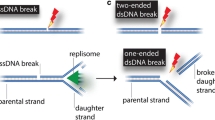DNA repair synthesis induced by methyl methanesulfonate in preconditioned HeLa cells in which DNA replicative synthesis had been highly suppressed was inhibited by aphidicolin (an inhibitor of DNA polymerases α and δ) and dideoxythymidine (ddThR, an inhibitor of DNA polymerase β). Incomplete repair patches sensitive to exonuclease III were accumulated in the presence of aphidicolin while not in the presence of ddThR. These patches were comopleted by the combined action of Klenow fragment and T4 DNA ligase, indicating that the single-stranded gaps were formed during the repair synthesis. Moreover, ddThR had little effect on the repair synthesis in the presence of aphidicolin. Thus, the results suggest that the single-stranded gaps may be sealed first by aphidicolin-sensitive polymerase followed by ddThR-sensitive DNA polymerase on the same site of the repair patch.
Similar content being viewed by others
Abbreviations
- ddThR:
-
dideoxythymidine
- MMS:
-
methyl methanesulfonate
- dNTP:
-
deoxynucleoside triphosphate
References
CLEAVER, J.E. (1981). Sensitivity of excision repair in normal human, xeroderma pigmentosum varient and cockaine's syndrome fibroblasts to inhibition by cytosine arabinoside. J. Cell. Physiol. 108:163–173.
CLEAVER, J.E. (1983). Structure of repaired sites in human DNA synthesized in the presence of inhibitors of DNA polymerase alpha and beta in human fibroblasts. Biochem. Biophys. Acta. 739:301–311.
CLEAVER, J.E. (1984). Completion of excision repair patches in human cell preparations: Identification of a probable mode of excision and resynthesis. Carcinogenesis 5:325–330.
CLEAVER, J.E. and PARK, S.D. (1986). Enhanced ligation of repair sites under conditions of inhibition of poly(ADP-ribose) synthesis by 3-aminobenzamide. Mutat. Res. 173:287–290.
CRUTE, J.D., WAHL, A.F., and BAMBARA, R.A. (1986). Purification and characterization of two new high molecular weight forms of DNA polymerase δ. Biochemistry 25:26–36.
DRESLER, S.F. and LIEBERMAN, M.W. (1983). Identification of DNA polymerases involved in DNA excision repair in dipoloid human fibroblasts. J. Biol. Chem. 258:9990–9994.
DRESLER, S.L. and FRATTINI, M.G. (1986). DNA replication and UV-induced repair synthesis in human fibroblasts are much less sensitive than DNA polymerase to inhibition by butylphenyl- deoxyguanosine triphosphate. Nucleic Acid Res. 14:7093–7102.
KEYSE, S.M. and TYRRELL, R.M. (1985). Excision repair in permeable arrested human skin fibroblasts damaged by UV (254 nm) radiation: Evidence that α- and β-polymerases act sequentially at the repolymerization step. Mutat. Res. 146:109–119.
McQUEEN, C.A., ROSADO, R.R. and WILLIAMS, G.M. (1989). Effect of nalidixic acid on DNA repair in rat hepatocytes. Cell Biol Toxicol 5:201–206.
MILLER, M.R. and CHINAULT, D.N. (1982). The roles of DNA polymerase α, β and γ in DNA repair synthesis induced in hamster and human cells by different DNA damaging agents. J. Biol. Chem. 257:10204–10209.
MOSBAUGH, D.W. and LINN, S. (1984). Gap-filling DNA synthesis by HeLa DNA polymerase alpha in an in vitro base excision DNA repair scheme. J. Biol. Chem. 259:10247–10251.
NISHIDA, C., REINHARD, P. and LINN, S. (1988). DNA repair synthesis in human fibroblasts requiress DNA polymerase δ. J. Biol. Chem. 263:501–510.
PARK, I.S., KOH, H.Y., PARK, J.K. and PARK, S.D. (1989). Two different mechanisms are involved for the bleomycin-induced DNA repair synthesis in permeabilized HeLa cells. Biochem. Biophys. Res. Comm. 164:1226–1233.
PARK, S.D. and CLEAVER, J.E. (1979). Post-replication repair: Question of its definition and possible alteration in xeroderma pigmentosum cells strains. Proc. Natl. Acad. Sci. U.S.A. 76:3927–3931.
WANG, T.S. and KORN, D. (1980). Reactivity of KB cell deoxyribonucleic acid polymerases α and β with nicked and gapped deoxyribonucleic acid. Biochemistry 19:1782–1790.
YAMADA, K., HANAOKA, F. and YAMADA, M. (1985). Effects of aphidicolin and/ or 2′,3′-dideoxythymidine on DNA repair induced in HeLa cells by four types of DNA-damaging agents. J. Biol. Chem. 260:10412–10417.
Author information
Authors and Affiliations
Rights and permissions
About this article
Cite this article
Park, IS., Park, J.K., Koh, H.Y. et al. DNA single stranded gaps formed during DNA repair synthesis induced by methyl methanesulfonate are filled by sequential action of aphidicolin- and dideoxythymidine sensitive DNA polymerases in HeLa cells. Cell Biol Toxicol 7, 49–58 (1991). https://doi.org/10.1007/BF00121329
Accepted:
Issue Date:
DOI: https://doi.org/10.1007/BF00121329




